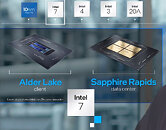
Intel Abandons In‑House Glass Substrate R&D, Leans on External Suppliers
Under its new CEO, Lip-Bu Tan, Intel is stepping back from building its glass substrate technology in favor of sourcing ready-made solutions from specialized vendors. Driven by Tan's strategy to concentrate resources on Intel's primary lines, CPU/GPU development, and foundry, Intel's operations are becoming leaner. By outsourcing glass substrates, Intel can significantly reduce development timelines and mitigate the financial risk associated with pioneering novel substrate manufacturing. Crucially, this model grants Intel the freedom to evaluate multiple suppliers, pivot quickly if performance or cost benchmarks change, and integrate advanced packaging more rapidly than if it continued to develop substrates internally. Just as the company is focusing on 14A and 18A-P(T), abandoning in-house glass substrate development is a step in the right direction to reduce costs and achieve profitability.
Meanwhile, the glass‑substrate sector is gathering momentum, particularly among South Korean firms. SK Hynix, in partnership with Applied Materials, has been trialing its Absolics pilot line for some time, while Samsung has recently scaled up its efforts in this niche. JNTC celebrated the opening of its first glass‑substrate plant in May, announcing sixteen prospective clients and projecting revenues to climb from $14.7 million this year to $147 million in 2026, and ultimately hitting $735 million by 2028. A complementary facility under construction in Vietnam will triple the original plant's output, targeting a combined annual production of roughly 500,000 substrates. Intel hasn't yet named which suppliers it will partner with. Still, the company plans to tap into this growing network, potentially joining JNTC's customer roster, to support its advanced packaging roadmap and accelerate product rollouts.
Meanwhile, the glass‑substrate sector is gathering momentum, particularly among South Korean firms. SK Hynix, in partnership with Applied Materials, has been trialing its Absolics pilot line for some time, while Samsung has recently scaled up its efforts in this niche. JNTC celebrated the opening of its first glass‑substrate plant in May, announcing sixteen prospective clients and projecting revenues to climb from $14.7 million this year to $147 million in 2026, and ultimately hitting $735 million by 2028. A complementary facility under construction in Vietnam will triple the original plant's output, targeting a combined annual production of roughly 500,000 substrates. Intel hasn't yet named which suppliers it will partner with. Still, the company plans to tap into this growing network, potentially joining JNTC's customer roster, to support its advanced packaging roadmap and accelerate product rollouts.












































